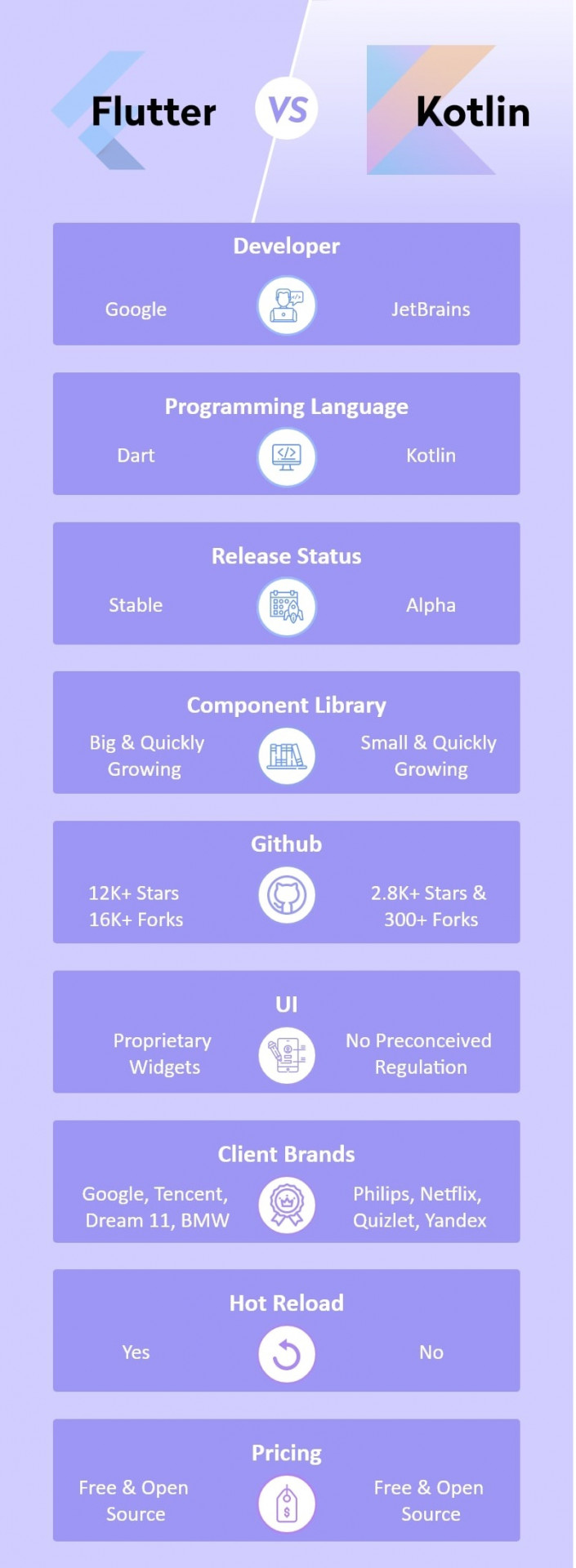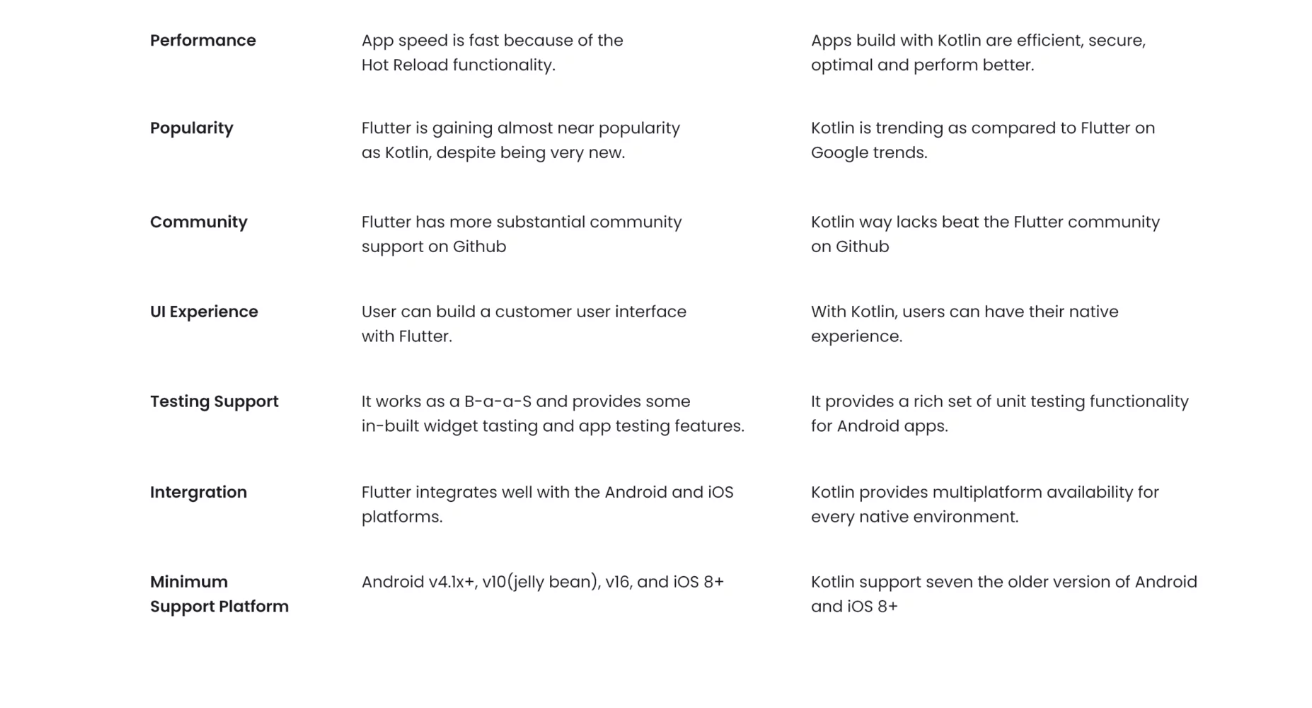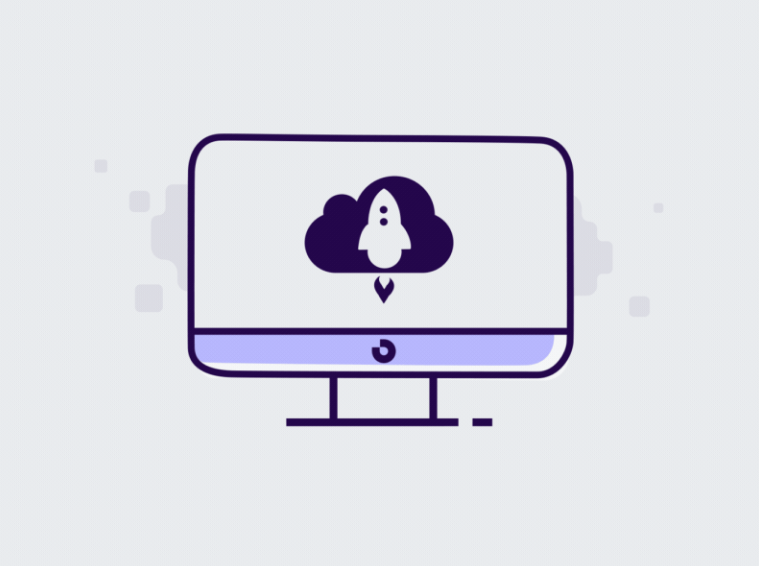Cross-platform development has become more popular than native. This is a quick way to the market, short time and money, and most importantly, a single code for all platforms. So what to pick for your cross-platform project — Flutter or Kotlin, or Kotlin multiplatform? What’s better?

Cross-platform app frameworks and benefits
The tools developers use to make apps for several frameworks are cross-platform app frameworks. Unlike native platforms, cross-platform frameworks like Flutter or Kotlin enable developers to create an app once and run on all of them, including Windows, iOS, and Android, with a few minor changes to the development process.
What advantages do cross-platform apps offer? Reaching a vast audience is an advantage of cross-platform apps. Businesses may target their consumers on many platforms rather than just one because these apps can be produced on various platforms while integrating seamlessly.
So, Flutter or Kotlin? Let’s look at each of them.
What is Kotlin?
Kotlin is a programming language, a general-purpose one made to complete interactivity with Java. Google has long officially supported the language for Android applications. It quickly gained popularity after the official recognition of Google and is popular nowadays.
According to a Stack Overflow survey, Kotlin has been consistently listed as a new favorite among programmers for the third year in a row. It is officially backed by Google, used by Jira and Adobe, and the developers of top Android applications rewrite their products in Kotlin.
Developed in 2011 to replace Java, Kotlin is a programming language created by JetBrains. The company considered Java to be too verbose, so they created the new language, which is 40% more compact and helped speed up work on JetBrains’ main product, the IntelliJ IDEA development environment. At the same time, Kotlin remained fully compatible with Java because it ran on its virtual machine (JVM).
If you give a formal definition, Kotlin is an object-oriented language with static typing.
Potentially, Kotlin can be used wherever Java works: this is the backend, the web, the desktop, and a bunch of other tasks. The language creator once said: “Kotlin is a language for all platforms.” And there is a lot of truth in this.
Nevertheless, each language often occupies its niche, where most programmers use it and have the most impact. Kotlin has two of them so far. This is server and mobile development. Although it can be increasingly found in other areas, such as science and Data Science, it’s still the favorite in mobile app development.
Kotlin and Java
Java has a large community, many libraries, solutions, and ready-made modules. Roughly speaking, developers can quickly get help if they encounter a problem. But in the case of Kotlin, it’s quite the opposite. The language is newer, and the issues are associated with libraries like Kotlinx.Serialization or Exposed makes it worth researching for a long time, looking for specific solutions. Besides, Java syntax suggests that the code will be more staffed than in Kotlin, and therefore, writing will take more time, etc.
Features
Kotlin is more understandable and concise. It comes with a set of tools and frameworks that work with Java. This reduces the number of lines of code and minimizes the number of bugs. Kotlin has an advanced compiler that can check errors at compile and run times. To find out more about the features of Kotlin or Flutter, you may review the pros and cons sections further on.
Thanks to JVM compatibility, Kotlin can be run on any Java server. Therefore, it is often used to create a backend, that part of the system that runs on the server beyond the average user’s view. For example, Jira cloud services and some Adobe products already run on Kotlin.
Pros and Cons of Kotlin
- Increased performance
One of the best features of the Kotlin programming language is its efficiency. If you know Java, learning it is easier than learning Kotlin vs. Flutter. It has a low learning curve.
- Server friendly
This niche is one of the priorities for the Kotlin team. And despite the popularity of Kotlin in mobile development, JetBrains DevRel teams talk about their language exclusively in the context of server development without mentioning mobile at all.
- Minimal code
Kotlin allows developers to build applications with minimal code. With code length at least one-fifth shorter than Java, it improves performance and increases the chances of creating high-quality applications.
- Extension functions
Extension functions, a.k.a standard library functions, can help Kotlin developers in many ways. Functions are an integral part of an object-oriented programming language. Kotlin lets developers use these features as extensions. This makes the process of adding new features super smooth.
- Lazy loading
You may have come across Lazy loading in web development. Likewise, lazy loading only loads the necessary initial content of the application and significantly reduces loading time. Lazy loading is one of the main reasons to learn the Kotlin language. After all, long loading times and slow performance ruin any Android app.
- NullPointerException
Null pointer safety greatly benefits developers in the early stages of development. It distinguishes between references that can contain null (null references) and the ones that cannot (non-null references) and ultimately reduces the risk of NullPointerException being thrown at runtime.
- The collections API
Kotlin is an up-to-date programming language that knows how to deal with immutable collections. The rich functional Kotlin APIs are automatically returned as collections and feature identical functionality.
Apps based on Kotlin
What is better for apps, Kotlin or Flutter? Among the most prominent names that have used Kotlin for Android App Development, you may find the following popular platforms:
- Postmates,
- Evernote,
- Corda,
- Coursera,
- Uber, etc.
Which is better Flutter or Kotlin? This depends, yet we know many leading companies trust Kotlin. These include Philips, Netflix, Leroy Merlin, and VMWare.
Today, 80% of the most downloaded programs in the Play Market are written in Kotlin, including applications from Netflix, Twitter, Reddit, and Google itself.
What is Flutter?
Now, let’s look at Flutter vs. Kotlin’s performance. Flutter is a framework toolkit based on the DART programming language. This is a Google toolkit for assembling native, compiled, quite functional applications and also for websites and desktop computers. But is Flutter better than Kotlin?
There is a fast-growing active community that supports novice developers. You can write applications for Android, iOS, Linux, Windows, Mac, Google Fuchsia, and ordinary websites in Flutter. All this is on a common Codebase: a single code standard for everything.
Flutter is an open-source framework. Google has developed it and lets you create mobile applications for either iOS or Android easily.
In most cases, one language is used to create applications on Flutter, and that’s Dart. Initially, it allowed writing applications only for mobile platforms, but just a couple of years ago, the Dart 2.6 version appeared, and the development of desktop programs became available. To compare Kotlin vs Dart Flutter, you must look at its performance.
Flutter creates its widgets and uses the GPU for rendering rather than borrowing native components from other platforms. Flutter contains two sets of widgets. The first, Material Design, uses Google’s design language of the same name. A second set of widgets called Cupertino implements Apple’s iOS Human interface guidelines.
Mind that Flutter is a relatively new framework. Although its prototype appeared in 2015 and the alpha version in May 2017, the first stable release – Flutter 1.0 – was released only in December 2018. Nevertheless, sub-versions are released regularly with a minor frequency, adding new functionality and fixing existing bugs. The latest stable version is Flutter 3, released in May 2022. Still, new sub-versions are constantly being released, bringing innovations to the framework (for example, the latest sub-version is 3.0).
Features
The peculiarity of applications on Flutter is that they are compiled into machine code through the usage of the graphics and rendering engine built into C / C ++. Thus, the software becomes almost untellable from the native one, and its performance capabilities increase significantly.
Pros and Cons of Flutter
One of the cons of Flutter is that the final installation package is more significant since the Dart virtual machine is added. Thus, when it comes to Kotlin vs Dart Flutter, there are Flutter files. Virtual machines get added depending on whether iOS or Android is being compiled. Now, let’s switch to the pros.
- One codebase for all platforms
Gone are the days of writing code first for Android and then another codebase for iOS gadgets. There’s no need for that due to the multiplatform Flutter tools.
- Graphic interface
A mobile app is created in the Dart programming language with a graphic interface description and all the work logic. The result of the work is added to the native application, as are pictures, fonts, and the like (of course, this process is automated).
The interface is easily broken down into separate modules for each framework. Creating screens differs significantly from those used on Android and iOS. In Android, logic and interface are separated. The code defines the logic, and the layout in XML defines the interface. On Flutter, all this is set using code. However, a unique style is used here for the interface – interface elements are created nested inside each other. This is a bit like layout, a very similar way to that which works in React Native. However, there is no possibility of direct access to the elements. To change something on the screen, you need to either update the entire screen or use special controllers added to the widget in advance during its creation.
Apps based on Flutter
How to create a successful app on Flutter? Here’s the list of the most popular apps that used Flutter for their app development:
- Google Ads.
- KlasterMe.
- Reflectly.
- Xianyu by Alibaba.
- Postmuse – Instagram photo editing app.
- Take Your Seat.
- Lunching.
- Pairing, etc.
Realtor.com will be a great example of a large company that turned to Flutter to help scale its cross-platform mobile development and improve its performance. Flutter is actively developed, so it is recommended for regularly updated apps.
Flutter vs Kotlin – How Popular are These Frameworks?
Flutter or Kotlin are both popular nowadays. Flutter works in Google, Square, eBay, BMW, Alibaba, and other companies with equally loud names. Flutter 2, recently released, was met with the community’s approval. Flutter has one of the most active communities.
Kotlin Multiplatform is also widely used, has an excellent reputation, and is used by many developers worldwide. It is flexible and easy to study, so the developers master it. For example, you may find Kotlin projects for Google, Adobe, Zomato, VMware, Ing Bank, Uber, Pinterest, Evernote, Coursera, Trello, Slack, UDEMY, etc.
So, what is the best language for mobile app development?
Detailed Comparison of Flutter and Kotlin
The difference between Kotlin and Flutter will show which technology to apply in this or that project. Here it is:

Source: Excellent Webworld
Stackoverflow stats
Flutter is loved, second only to .NET, because of the Flutter workflow. 68% love Flutter, 73% love .NET Source: Reddit
Finding Kotlin-related information on Stack Overflow is not easy.
Syntax
Regarding Kotlin Syntax, Kotlin allows you to write the same thing as Java using fewer lines (Extensions, Null Safety, Data Classes). Separately, it is worth noting the work with the UI: thanks to Android Extensions, you no longer need to deal with the boilerplate with findViewById.
Example:

Source: Tproger
Development Cost
Whereas the Average cost of Kotlin development (USD) is $ 27 Min, $ 49 Mediana, and $ 150 Max, the Flutter app development cost of a not too complex software, like a messenger with voice calls, for example, will be from $34,950 to $48,850. Developing an app like Instagram with complex features will ultimately cost from $41,500 to $55,000.
Documentation
Understanding documentation is one of the most critical topics when developing any software. There are several ways to learn it for Flutter and Kotlin, as they are frameworks with a solid documentation base and a good community, even though Flutter is relatively new compared to Kotlin.
Market Share
Based on the survey, 42 percent is the market share of software developers who use Flutter. Kotlin is used by TikTok, Instagram, and Microsoft OneDrive, not to mention Google. It boasts an impressive 15.99% market share. It has been used to develop more than 131,000 apps and downloaded more than 298 billion times worldwide.
Performance Comparison
Also, here’s a simple and detailed comparison offered by Treinetic:

What does Flutter development use? To write the program code, you can use any text editor and then compile the application using the command line utilities from the Flutter SDK. However, for environments such as Android Studio, IntelliJ IDEA, and the Visual Studio Code text editor, Google has released special plugins that make development easier. Therefore, Android Studio and IntelliJ IDEA are often used for developing under Flutter.
Tools Integration
Panache is a Flutter material editor tool that over 40 million Flutter app developers use to create beautiful and successful applications. In Panache, developers mix different themes and fonts with this Material Design-inspired, open-source tool.2. Also, Flutter offers a range of tools for integration: Codemagic, Appetize, Visual Studio Code, Android Studio, Supernova, Adobe Plugins or Firebase.
Kotlin works with different build tools. It’s great if you’re using a standard tool such as Ant, Maven Gradle, etc.
Which language is better to learn?
Flutter and Kotlin are the two top technologies used to build mobile applications. Kotlin has an easy learning curve because it is very similar to Java. In Flutter, developers must learn Dart programming to build an app. As for the job prospecting, whichever you know, Flutter or Kotlin, your future should be bright.
Job opportunities
Becoming a highly trained Kotlin developer offers a wide range of chances. Acquiring outstanding Kotlin abilities is sufficient to find employment. With your Kotlin talents, you can work on Android apps, web development, data science, and mobile app development. The average compensation for an Android Kotlin developer in the USA is $130,000 per year or $62.50 per hour. Most experienced workers earn up to $155,700 annually, while entry-level occupations start at $108,000 annually.
The need for experienced and qualified Flutter developers has skyrocketed in recent years, particularly in the mobile app sector. The benefits of using Flutter can be directly linked to this rise in demand. Flutter Developer in the US is looking at an average annual salary of $101,554 as of February 12, 2023. That comes to about $48.82 an hour, the same as $1,952 each week or $8,462 per month.
Flutter vs. Kotlin Trends
Flutter is a framework from Google. It allows you to make cross-platform applications that use the same code. The range of platforms goes from web applications, mobile applications for iOS and Android, and graphic applications to desktop operating systems. Think Windows, MacOS, Linux, web applications, and more.
Kotlin, after all, is better when a new Android project starts, or you need to adjust quickly to the existing project. Kotlin cross-platform is already very good (although it is experimental) when the large size of the resulting application and its numerous overgrown dependencies are not so important to you. A cross-platform app development company knows that for sure.
Most existing Android applications are written in Java, and you should not hope they will be rewritten in Kotlin soon. And since the UI of the Android operating system is developed in Java, this language has an SDK and many ready-made libraries. Hence, several companies still prefer Java and will like it in the future.
What is better in 2024?
Flutter is a framework that is great for the developer’s time and saves costs. Flutter is very good for creating MVP (Minimum Viable Products), working prototypes, and applications that are quite simple but wholly efficient and can immediately attract a mass client. Prototypes are Flutter when time and money are burning.
Apps developed in Flutter don’t usually take much time to build, which is why they are considered cheaper than native apps. Hence, it is perfect for MVP startups, especially when testing your new business model ASAP: Flutter app development cost will be lower than native development for the two platforms.
Kotlin is supported by JetBrains, where many unique products run on Java, and other things make life easier for the programmer. Kotlin is aimed at eliminating some “narrow places” in Java. Complete interchangeability with Java is the most crucial reason why Kotlin is popular. It can be included in a long-existing project, a cross-platform application, and even in the code for the server side.
Suppose you want to write a mobile application that works on iPhones and Android smartphones. In this case, cross-platform development can help. This is when we write the code once and then adapt it to several systems. Kotlin has a technology that allows you to do this called Multiplatform. Quite many companies are already using it.
When to Use Flutter?
Flutter can be used in small, medium, and large companies. According to the sum of reviews, Flutter is best shown in developing online stores, fintech, business applications, and other Android application development services.
You can build mobile apps on Flutter via Serverless technology. The main advantage of Serverless when developing applications on Flutter is the ability to focus the developer’s efforts and all financial resources entirely on the mobile application’s functionality. Serverless technology is very elastic – the service provider provides computing resources only as needed; the greater the load on the application, the more resources are provided. This also affects the cost of maintenance. You do not pay for computing resources if the application is not used. The speed of the application also increases.
When to Use Kotlin?
Kotlin is said to be helpful for any software development, be it server-side, client-side web, or Android. With the help of Kotlin/Native currently in the works, support for other platforms is coming (these include embedded systems, macOS, and iOS.)
In addition to the backend, there is also a frontend, which is the facade side of the online app. These are different buttons, drop-down menus, and windows that users interact with. Almost the entire front end is written in one language: JavaScript. And Kotlin knows how to compile to JavaScript. And this version of it can be used to create a frontend. It is possible to write both the logic and the interface in Kotlin. Since the entire web application can be created using it as a universal tool, this makes it an incredibly sought-after technology in app development.
Conclusion
It is essential to understand that no ideal frameworks and languages exist. Dart and Kotlin have their pros and cons. Both languages generally perform well and are relatively inexpensive in time and money.
Flutter has been more popular than Kotlin, although it looks more decent in Android development. As for the cross-platform, both platforms give almost native applications with a single code so that you may use it for your project.
Not sure what to choose for your development project? We at Fireart Studio help to take new products from ideation to market every day. Contact us if you have any questions, and we’ll be happy to help you reach your goals.




















